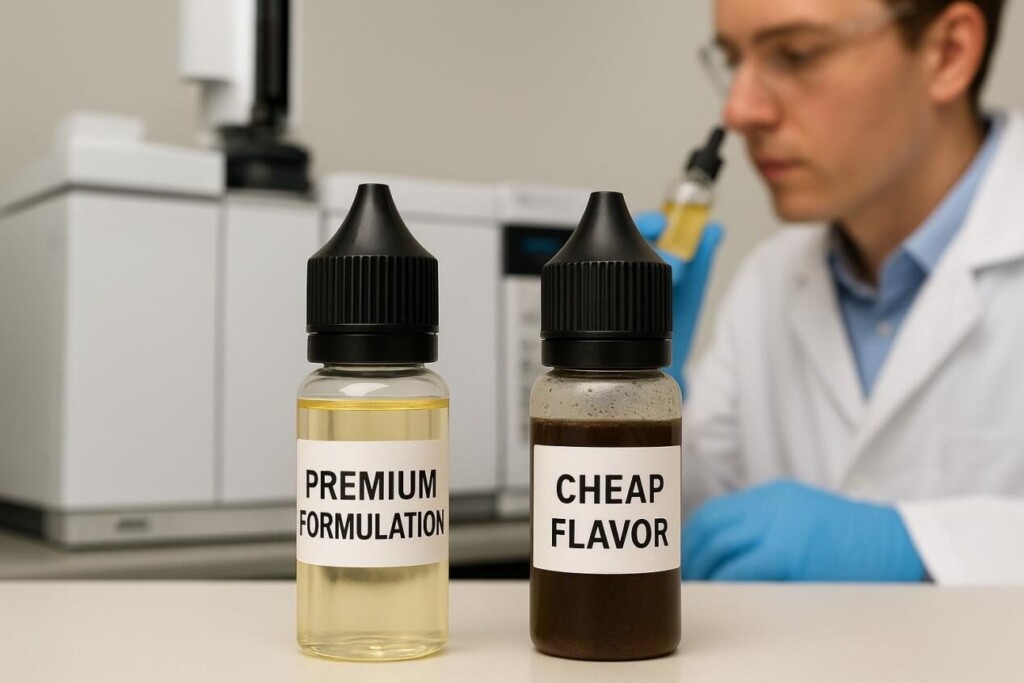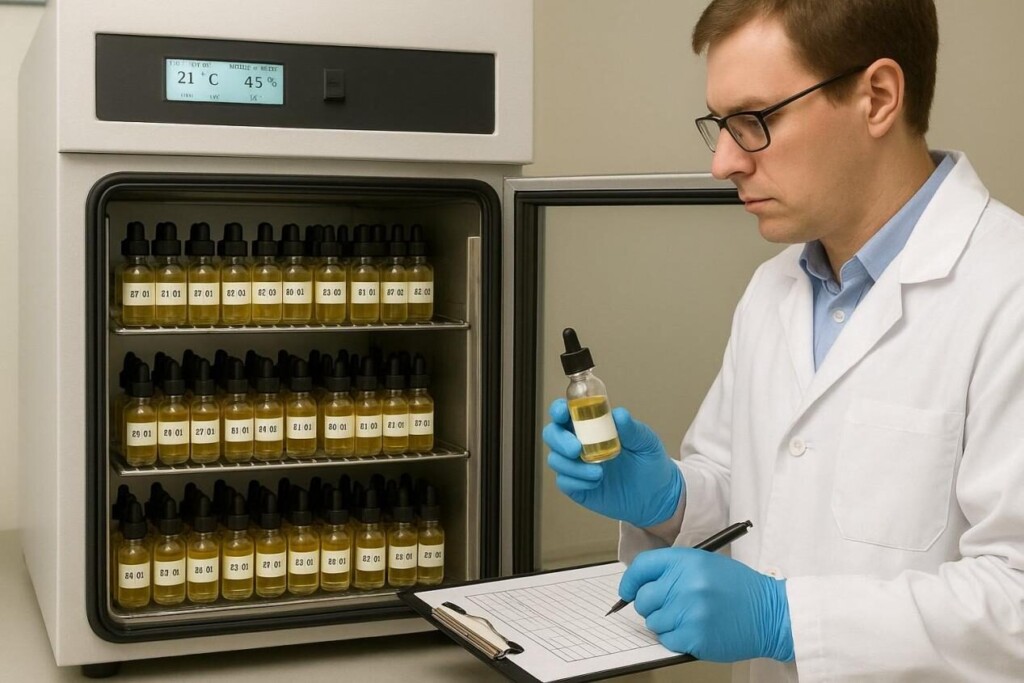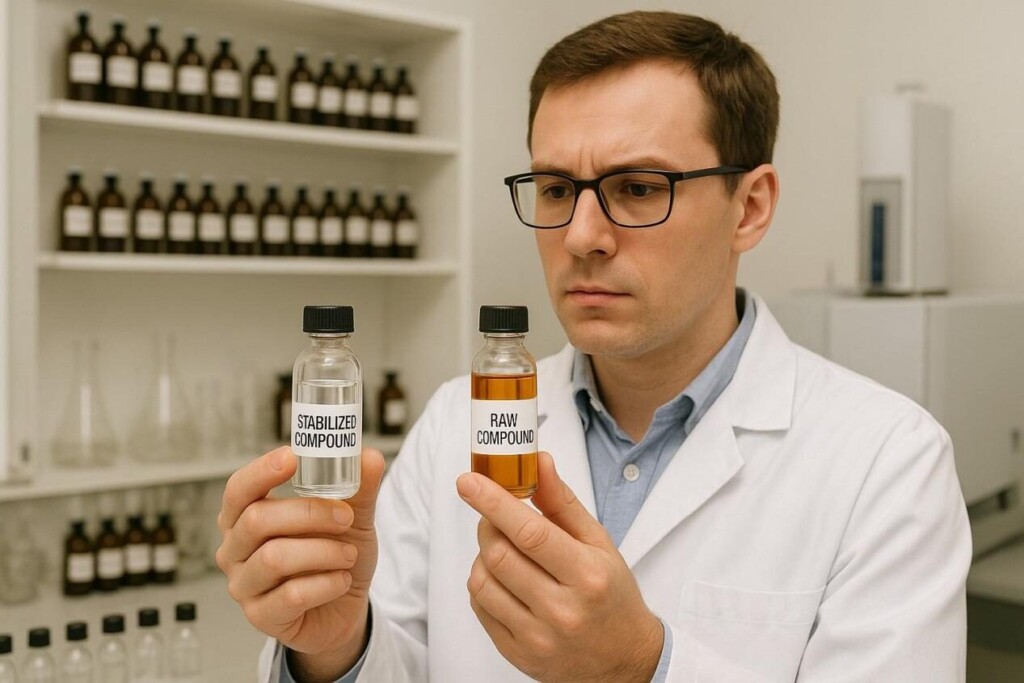Author: R&D Team, CUIGUAI Flavoring
Published by: Guangdong Unique Flavor Co., Ltd.
Last Updated: Nov 17, 2025

Premium vs Cheap E-Liquid – Lab Comparison
In the highly competitive electronic liquid (e-liquid) industry, brands often face the temptation to reduce formulation costs by choosing cheaper flavorings. While this may appear financially prudent in the short term, it frequently leads to consumer dissatisfaction, brand damage, and even regulatory issues in the long run.
Flavorings are the emotional core of every vape experience—they define first impressions, brand loyalty, and sensory quality. A single inferior compound can ruin an otherwise well-engineered formula, leading to taste instability, harsh notes, or chemical degradation that consumers immediately recognize.
According to Grand View Research (2023), the global e-liquid flavor market is expanding at a CAGR of over 12%, with growing emphasis on premium, authentic, and safe flavor formulations. Yet, within this growth lies a divide between short-term profit-seekers using cheap raw materials and long-term innovators investing in purity, consistency, and science.
This article explains—scientifically and strategically—why cheap flavorings lead to consumer rejection, how chemical instability manifests in vaping systems, and how manufacturers can build sustainable competitive advantages through quality-driven flavor development.
Cheap flavorings are not simply “low-cost.” They are typically low-purity, poorly stabilized, or non-optimized aromatic formulations that fail under real-world conditions.
While some producers use cheap ingredients to reduce formulation costs by 30–40%, the downstream effect—consumer rejection, flavor complaints, and market distrust—can erase months of brand-building efforts.
A 2022 Euromonitor report found that more than 60% of e-liquid users associate brand trust with consistent flavor quality, not price. Once that trust is broken by an off-flavor or inconsistency, brand recovery becomes exponentially harder.
Flavor science is chemistry in action. Cheap flavorings often fail because they violate basic principles of molecular stability and sensory balance.
Low-cost raw materials often contain residual solvents, peroxides, or aldehydic impurities that alter over time.
The U.S. National Institutes of Health (NIH) reports that oxidation of volatile organic compounds can significantly affect product aroma stability, especially under high-temperature conditions like vaping (NIH PubChem, 2024).
Cheap flavoring systems often use poorly matched solvents or carriers (PG/VG ratios), leading to phase separation or sedimentation. This causes inconsistent delivery of aroma during atomization, resulting in:
High-quality flavors are engineered for molecular compatibility with propylene glycol and vegetable glycerin matrices. In contrast, low-grade blends often mix compounds with incompatible volatility or polarity, causing:
Such instability makes the vape experience unpredictable from puff to puff—a major driver of consumer complaints.
Nicotine and certain acidic additives are reactive species. Poorly stabilized flavorings can chemically react with them, producing dark discolorations or even off-odors over time.
As explained in the Journal of Analytical Toxicology, chemical interactions between flavor aldehydes and nicotine can generate unwanted Schiff base compounds that alter both aroma and safety profiles (Journal of Analytical Toxicology, 2021).
Consumers expect realistic, consistent aromas—strawberries that smell natural, tobaccos that feel authentic. Cheap flavors often use synthetic shortcuts, leading to artificial, “chemical” impressions.
A sensory panel study from the University of Nottingham (2023) showed that consumer preference strongly correlates with flavor realism, and artificial-tasting notes reduce overall satisfaction by up to 45%.
Unpurified or unstable compounds often introduce reactive byproducts during vaporization. These can irritate mucous membranes, leading to consumer reports of:
Low-quality flavorings degrade differently across batches or storage conditions. Users experience flavor drift—the same flavor tastes fresh one week, dull or sour the next.
This inconsistency is a trust killer, especially in regions like the EU where product repeatability is a legal requirement under the Tobacco Products Directive (TPD).
Chemical degradation manifests visually: darkening liquid, fading top-notes, and sour undertones. Once consumers associate your brand with “color shift” or “off-taste,” retention rates plummet.

E-Liquid Degradation Comparison with GC–MS Results
Beyond chemistry, flavor quality directly shapes brand perception. The vaping experience is emotional—it connects with memory, satisfaction, and identity. Cheap flavorings disrupt this connection.
According to Harvard Business Review, consumers form lasting brand impressions within the first seconds of product use. In e-liquids, that moment is the first puff. If it tastes harsh, chemical, or inconsistent, the user rarely gives a second chance.
Flavor trust builds over time. Users come to expect the same sensory profile each time they refill or repurchase. When cheap flavors cause drift or inconsistency, consumers perceive the brand as unreliable or unsafe—even if no actual health issue exists.
In the digital era, a single negative review on Reddit, YouTube, or vaping forums can reach thousands of potential customers. Poor flavor quality spreads faster than marketing campaigns, damaging brand equity beyond repair.
Cheap flavors often lack documentation for:
Lack of documentation can lead to regulatory rejections, export restrictions, or product recalls.
The European Chemicals Agency (ECHA) emphasizes that unregistered or improperly characterized chemicals pose unknown risks to human health and product stability (ECHA, 2024).
Without analytical validation, cheap flavorings may contain trace levels of diacetyl, acetoin, or acetyl propionyl—compounds linked to respiratory irritation when inhaled in high concentrations.
Even if present in trace amounts, the lack of disclosure violates international labeling laws and ethical manufacturing standards.
Premium flavor suppliers perform accelerated stability testing (e.g., 40°C/75% RH for 6 weeks) to ensure shelf life and composition consistency. Cheap suppliers rarely provide this data, leaving manufacturers blind to degradation rates and possible harmful byproducts.

E-Liquid Stability Test in Laboratory
A cheap flavor may save $5 per kilogram, but the brand equity loss from consumer rejection can cost tens of thousands in lost revenue.
Consider this scenario:
Once a flavor line gains a reputation for poor quality, reformulating it isn’t enough—you must rebuild trust. This means:
These corrective actions often cost far more than the initial savings from cheap materials.
Retailers prefer reliable brands with low return rates. Cheap, unstable flavors lead to higher return rates, complaint volumes, and inventory write-offs. Once distributors lose confidence, shelf space becomes impossible to regain.
The antidote to consumer rejection lies in precision chemistry, traceable sourcing, and scientific formulation—all of which define CUIGUAI Flavoring’s approach to e-liquid fragrance development.
Each aroma component undergoes Gas Chromatography–Mass Spectrometry (GC–MS) testing to verify identity, purity, and consistency. This ensures no unknown peaks (impurities) are present.
Premium flavor systems include:
These measures extend flavor shelf life while maintaining brightness and clarity.
Instead of random mixing, stable flavors are built using modular design—pre-characterized bases (cream, mint, fruit, tobacco) with known stability indexes.
This modularity ensures reproducible flavor combinations, reducing batch-to-batch variability.
Each formulation passes:
This ensures the final aroma remains true-to-profile after months of storage.
CUIGUAI Flavoring provides:
This builds confidence with both B2B clients and regulators.

Fragrance Chemist Comparing Stabilized and Raw Compounds
Every puff tells a story—smooth inhale, balanced flavor, satisfying aftertaste. Cheap flavorings break that story by introducing unwanted notes, inconsistency, and distrust. Premium flavors sustain emotional continuity, ensuring that what the user loved yesterday tastes the same tomorrow.
In the end, consumers reject cheap flavorings not because of price—but because of experience. Once that trust is broken, it’s nearly impossible to regain.
Investing in scientifically stable, GC–MS verified, and regulatory-compliant flavor systems is not an expense—it’s a long-term strategy for brand growth and survival.
Cheap flavorings may offer temporary cost relief, but their hidden risks—chemical instability, safety issues, and consumer distrust—inevitably outweigh their savings.
In the modern e-liquid market, where consumers are more informed and quality-conscious than ever, cheap equals rejection.
Brands that choose premium, scientifically validated flavors not only avoid rejection but also build lasting loyalty, regulatory trust, and market leadership.
CUIGUAI Flavoring stands as a partner for those who pursue long-term excellence over short-term cost cutting.
For technical collaboration, stability consulting, or free sample requests, contact our technical team today:
📧 Email: [info@cuiguai.com]
🌐 Website: [www.cuiguai.com]
📱 WhatsApp: [+86 189 2926 7983]
☎ Phone: [+86 0769 8838 0789]
Let’s build the next generation of stable, compliant, and consumer-loved flavors together.
The business scope includes licensed projects: food additive production. General projects: sales of food additives; manufacturing of daily chemical products; sales of daily chemical products; technical services, technology development, technical consultation, technology exchange, technology transfer, and technology promotion; biological feed research and development; industrial enzyme preparation research and development; cosmetics wholesale; domestic trading agency; sales of sanitary products and disposable medical supplies; retail of kitchenware, sanitary ware and daily sundries; sales of daily necessities; food sales (only sales of pre-packaged food).
Copyright ©Guangdong Unique Flavor Co., Ltd.All Rights Reserved. Privacy Policy